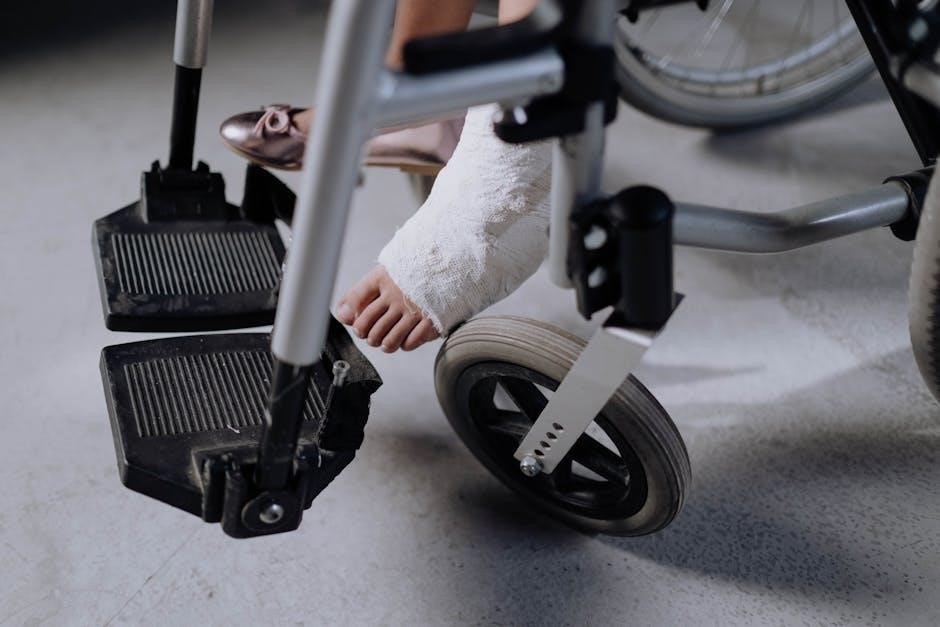The pelvic fracture rehabilitation protocol pdf provides guidelines for treatment and recovery, including physical therapy and pain management, using a comprehensive approach to rehabilitation always effectively.
Overview of Pelvic Fractures
Pelvic fractures are rare, accounting for 3-8% of total fractures, but have a high mortality rate of 5-40%. They often occur in conjunction with other life-threatening injuries, making treatment complex. The fractures can be classified into different types, including stable and unstable fractures, each requiring a unique approach to treatment. A comprehensive understanding of pelvic fractures is essential for developing effective rehabilitation protocols. The Internet provides a wealth of information on pelvic fractures, including research articles and rehabilitation guidelines. According to various studies, pelvic fractures can be caused by high-energy trauma, such as car accidents, or low-energy trauma, such as falls. The severity of the fracture and associated injuries play a crucial role in determining the treatment and rehabilitation plan. Pelvic fracture rehabilitation protocol pdfs are available online, providing detailed guidelines for treatment and recovery.
Importance of Hemodynamic Stability
Hemodynamic stability is crucial for effective pelvic fracture treatment and recovery always requiring careful monitoring and management techniques effectively.
Identifying Hemodynamic Stability
Identifying hemodynamic stability is a critical step in the treatment of pelvic fractures, requiring careful evaluation of the patient’s condition. The use of a pelvic binder can help control bleeding and stabilize the fracture. A comprehensive assessment of the patient’s vital signs, including blood pressure, heart rate, and oxygen saturation, is essential to determine hemodynamic stability. Additionally, imaging studies such as X-rays and CT scans can help identify the extent of the fracture and any associated injuries. By identifying hemodynamic stability, healthcare providers can develop an effective treatment plan and prevent further complications. This involves a multidisciplinary approach, including orthopedic surgeons, emergency medicine physicians, and other specialists. Effective communication and collaboration are essential to ensure the best possible outcomes for patients with pelvic fractures. Proper identification of hemodynamic stability is vital to prevent morbidity and mortality.

Rehabilitation Protocol
Rehabilitation protocol involves physical therapy and exercise to restore function and mobility always using a structured approach effectively every time with great care and patience.
Comprehensive Rehabilitation
A comprehensive rehabilitation program is essential for patients with pelvic fractures, including physical therapy, occupational therapy, and pain management. The goal of rehabilitation is to restore function, mobility, and independence. A multidisciplinary team of healthcare professionals works together to develop a personalized rehabilitation plan. This plan may include exercises to improve strength, range of motion, and flexibility, as well as education on proper body mechanics and injury prevention. Additionally, rehabilitation may involve the use of assistive devices, such as walkers or canes, to help patients with mobility and balance. The rehabilitation program is tailored to the individual’s needs and goals, with the ultimate goal of achieving optimal recovery and return to normal activities. By providing comprehensive rehabilitation, patients with pelvic fractures can achieve the best possible outcomes and improve their overall quality of life. Effective rehabilitation is a key component of the treatment plan.

Associated Injuries
Nerve lesions and other complications often occur with pelvic fractures requiring specialized treatment always effectively using various therapies and medications.
Nerve Lesions and Other Complications
Nerve lesions and other complications can occur with pelvic fractures, requiring specialized treatment and rehabilitation.
The pelvic fracture rehabilitation protocol pdf provides guidelines for managing these complications, including urinary and intestinal dysfunctions.
Nerve lesions can result in chronic pain, numbness, and weakness, affecting the patient’s quality of life.
Effective treatment and management of these complications are crucial to prevent long-term disability and improve patient outcomes.
The protocol outlines the importance of a multidisciplinary approach to rehabilitation, involving physical therapists, occupational therapists, and other healthcare professionals.
By following the guidelines outlined in the pelvic fracture rehabilitation protocol pdf, healthcare providers can ensure that patients receive comprehensive and effective care for nerve lesions and other complications.
This approach can help patients achieve optimal recovery and regain their functional abilities, reducing the risk of long-term disability and improving their overall well-being, always using various therapies.

Emergent Management
Emergency treatment involves stabilizing the patient and controlling bleeding, using a pelvic binder and other interventions to prevent further complications always effectively managed.
Emergency Treatment of Pelvic Fractures
Emergency treatment of pelvic fractures involves immediate intervention to stabilize the patient and prevent further complications. This includes applying a pelvic binder to help control bleeding and stabilize the fracture. The patient is then taken to the operating room for further treatment, which may include surgical stabilization of the fracture. The goal of emergency treatment is to prevent further injury and promote healing. A comprehensive approach to treatment is crucial in emergency situations, and a pelvic fracture rehabilitation protocol pdf can provide valuable guidance for healthcare professionals. The protocol outlines the steps to be taken in emergency situations, including assessment, treatment, and management of complications, to ensure the best possible outcomes for patients with pelvic fractures, and to reduce the risk of long-term disability. Effective emergency treatment is essential for optimal recovery.

Rehabilitation Guidelines
Rehabilitation guidelines are outlined in the pelvic fracture rehabilitation protocol pdf for healthcare professionals to follow always effectively and efficiently every time.
Standards for Practice
The pelvic fracture rehabilitation protocol pdf outlines standards for practice, including the application of a pelvic binder in the correct position to control hemorrhage, and the importance of identifying hemodynamic stability.
These standards are crucial in ensuring effective treatment and rehabilitation of patients with pelvic fractures, and are based on evidence-based practices and clinical guidelines.
The protocol also emphasizes the need for a multidisciplinary approach to care, involving healthcare professionals from various specialties, to ensure comprehensive rehabilitation and optimal outcomes for patients.
By following these standards for practice, healthcare professionals can provide high-quality care and improve patient outcomes, reducing morbidity and mortality associated with pelvic fractures, and promoting effective rehabilitation and recovery always.
Rehabilitation protocol pdf ensures proper recovery and minimizes complications always effectively using guidelines.
Importance of Proper Rehabilitation
The importance of proper rehabilitation in pelvic fracture cases cannot be overstated, as it plays a crucial role in ensuring the patient’s full recovery and minimizing potential complications. A well-structured rehabilitation protocol pdf is essential in guiding healthcare professionals through the treatment process. This includes a comprehensive approach to physical therapy, pain management, and occupational therapy, all of which are vital components of the rehabilitation process. By following a standardized protocol, healthcare providers can ensure that patients receive the best possible care, reducing the risk of long-term disability and improving overall outcomes. Effective rehabilitation also helps patients to regain their independence and return to their normal activities, which is a key aspect of the recovery process. Proper rehabilitation is essential for achieving optimal results and improving the patient’s quality of life. Rehabilitation protocols are continually updated to reflect the latest research and best practices.
